Search
Remove Ads
Advertisement
Summary 
Loading AI-generated summary based on World History Encyclopedia articles ...
Search Results
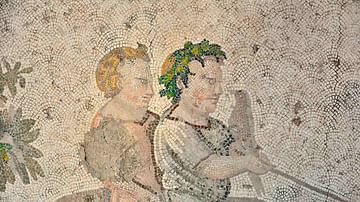
Image
Byzantine Mosaic of Children Seated on a Dromedary
Two children are seated on a dromedary. One of them wears a wreath around his head and is holding a bird in one hand and reins with the other hand. There is also a guide in front of them. Period: Early Byzantine, c. 6th century CE. Place...
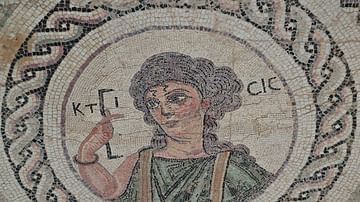
Image
Byzantine Mosaic with a Personification of Ktisis
Byzantine mosaic emblema in the House of Eustolios in Kourion (Cyprus) depicting a young woman in a medallion holding a measuring instrument equating to a Roman foot. The Greek inscription identifies her as Ktisis, the personification of...
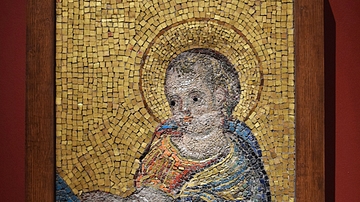
Image
Byzantine Mosaic of Christ Child
This mosaic of Jesus Christ as a child is rendered in Byzantine style and made by Jacopo Torriti (or "Turriti"). Torriti was an Italian painter and mosaic-maker during the late 13th century CE. He lived and worked in Rome, Italy. (Pushkin...
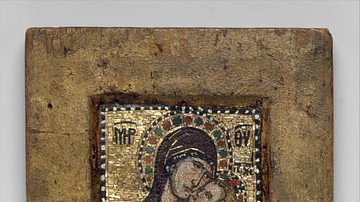
Image
Byzantine Mosaic Icon with the Virgin Eleousa
Portable icon of the Virgin and Child of the Eleousa type, the Virgin of Tenderness, miniature mosaic made of many tiny tesserae (mosaic stones), set in wood, early 14th century.
Metropolitan Museum of Art, New York.
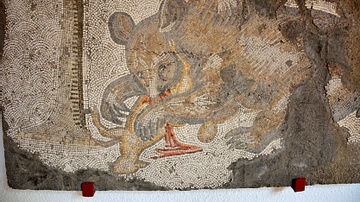
Image
Bear Hunting a Lamb, Byzantine Mosaic
Bear hunting a lamb, Byzantine Mosaic. Period: Early Byzantine, circa 6th. century C.E. Place: Constantinople, (Modern Istanbul, Turkey). Great Palace Mosaic Museum, Istanbul, Turkey. The Great Palace Mosaic Museum was inaugurated in 1987...
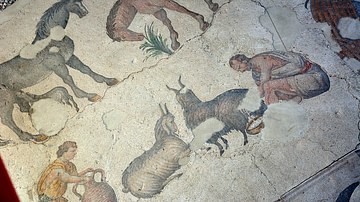
Image
Herdsman Milking a Goat, Byzantine Mosaic
Herdsman milking a goat: An old bearded shepherd is milking his goat and a boy is holding a milk jug. This scene reflects pastoral life. Period: Early Byzantine, circa 6th. century CE. Place: Constantinople, (Modern Istanbul, Turkey). Great...
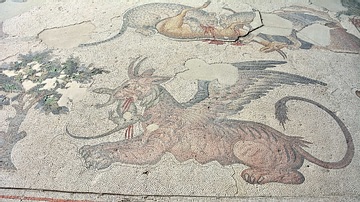
Image
Tigriss-Griffin Byzantine Mosaic
The tigriss-griffin: This tigriss (female) Griffin has two horns and wings and a wild look on its face. Crimson drops of blood come out of its mouth. Period: Early Byzantine, circa 6th. century C.E. Place: Constantinople, (Modern Istanbul...
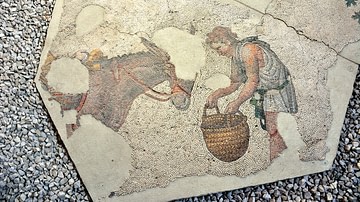
Image
Man Feeding Mule, Byzantine Mosaic
A man is feeding his mule, Byzantine Mosaic, Period: Early Byzantine, circa: 6th century CE. Place: Constantinople, (Modern Istanbul, Turkey). Great Palace Mosaic Museum, Istanbul, Turkey. The Great Palace Mosaic Museum was inaugurated...
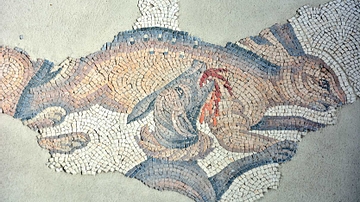
Image
Hunting Rabbits, Byzantine Mosaic
Hunting Rabbits: The dogs are attacking the rabbit on its neck and abdomen. The hunter is depicted having just released the dogs, Byzantine Mosaic, Period: Early Byzantine, circa: 6th. century CE. Place: Constantinople, (Modern Istanbul...
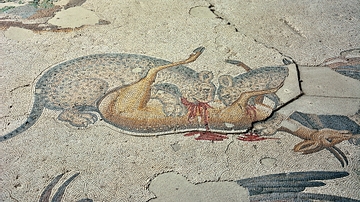
Image
Leopards Hunting Deer, Byzantine Mosaic
Leopards hunting a deer, Byzantine Mosaic, Period: Early Byzantine, circa: 6th century CE. Place: Constantinople, (Modern Istanbul, Turkey). Great Palace Mosaic Museum, Istanbul, Turkey. The Great Palace Mosaic Museum was inaugurated in...